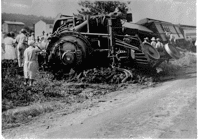
Although the mishap probably did not go down in the annals of Southern Railway History as one of the great train disasters of the century, the derailment at Daphna station caused quite a stir in the little town of Broadway.
Early on the morning of July 8, 1932, J.W. Chenault, husband of the Daphna postmistress, was waiting by the train tracks to get the mail pouch for the residents of the little community. He had this to say in an interview with The Daily News Record on July 9, the morning after the wreck: “I got ready to wave at Frank Breeden, the mail clerk, when he passed the station. As quick as a flash, the engine took the switch, began tearing the track to pieces and was wrecked. At first it looked like it was coming right towards me. I yelled and ran into the house and couldn’t talk. Mrs. Chenault rushed at me and wanted to know what was the matter. I pulled her outside and showed her the wrecked train.”
Engine 1214 had left Union Station in Harrisonburg earlier that morning. It had planned to stop in Strasburg, Front Royal and Washington D.C. in addition to Daphna. Plans came to an abrupt halt when a switch leading to the Daphna siding failed to work, and the train crashed on to its right side, tearing up the tracks as it slid.
Fortunately, there was only one passenger aboard, and no one was seriously injured. Engineer R.L. Goode and fireman M.C. Coons were burned, but were able to escape without life-threatening injury. Mr. Chenault was able to take the injured crew members to the hospital in his car.
News spreads quickly in small towns, Broadway was no exception. Soon, hundreds of people were lined up at the tracks and on the surrounding hillside. About 2500 spectators gathered to watch the cleanup. Members of the Broadway Presbyterian Church sold sandwiches to bystanders. Southern Railway sent a wrecker crew from Alexandria to raise the downed train and ease it on its way to the repair shop.
Passenger service from Harrisonburg to Alexandria was stopped in 1943 because of World War II, and was resumed briefly in 1946. However it drew too few passengers and was discontinued permanently in 1949.
Information for this post gathered from Regards to Broadway: The Story of an American Town (Cullers and Lilliendahl)
Early on the morning of July 8, 1932, J.W. Chenault, husband of the Daphna postmistress, was waiting by the train tracks to get the mail pouch for the residents of the little community. He had this to say in an interview with The Daily News Record on July 9, the morning after the wreck: “I got ready to wave at Frank Breeden, the mail clerk, when he passed the station. As quick as a flash, the engine took the switch, began tearing the track to pieces and was wrecked. At first it looked like it was coming right towards me. I yelled and ran into the house and couldn’t talk. Mrs. Chenault rushed at me and wanted to know what was the matter. I pulled her outside and showed her the wrecked train.”
Engine 1214 had left Union Station in Harrisonburg earlier that morning. It had planned to stop in Strasburg, Front Royal and Washington D.C. in addition to Daphna. Plans came to an abrupt halt when a switch leading to the Daphna siding failed to work, and the train crashed on to its right side, tearing up the tracks as it slid.
Fortunately, there was only one passenger aboard, and no one was seriously injured. Engineer R.L. Goode and fireman M.C. Coons were burned, but were able to escape without life-threatening injury. Mr. Chenault was able to take the injured crew members to the hospital in his car.
News spreads quickly in small towns, Broadway was no exception. Soon, hundreds of people were lined up at the tracks and on the surrounding hillside. About 2500 spectators gathered to watch the cleanup. Members of the Broadway Presbyterian Church sold sandwiches to bystanders. Southern Railway sent a wrecker crew from Alexandria to raise the downed train and ease it on its way to the repair shop.
Passenger service from Harrisonburg to Alexandria was stopped in 1943 because of World War II, and was resumed briefly in 1946. However it drew too few passengers and was discontinued permanently in 1949.
Information for this post gathered from Regards to Broadway: The Story of an American Town (Cullers and Lilliendahl)
 RSS Feed
RSS Feed
